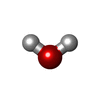Entry Database : PDB / ID : 9uhiTitle FGFR1 kinase domain with a covalent inhibitor 9o Fibroblast growth factor receptor 1 Keywords / / Function / homology Function Domain/homology Component
/ / / / / / / / / / / / / / / / / / / / / / / / / / / / / / / / / / / / / / / / / / / / / / / / / / / / / / / / / / / / / / / / / / / / / / / / / / / / / / / / / / / / / / / / / / / / / / / / / / / / / / / / / / / / / / / / / / / / / / / / / / / / / / / / / / / / / / / / / / / / / / Biological species Homo sapiens (human)Method / / / Resolution : 1.76 Å Authors Chen, X.J. / Chen, Y.H. Funding support Organization Grant number Country National Natural Science Foundation of China (NSFC) 82202920 National Natural Science Foundation of China (NSFC) 82172654
Journal : J.Med.Chem. / Year : 2025Title : Design, Synthesis and Biological Evaluation of 7-(1-Methyl-1 H -indole-3-yl)-5 H -pyrrolo[2,3- b ]pyrazine Derivatives as Novel Covalent pan-FGFR Inhibitors to Overcome Clinical Resistance.Authors : Deng, W. / Chen, X. / Yan, L. / Xiang, S. / Song, X. / Zhang, L. / Li, X. / Zhu, W. / Pei, J. / Lin, X. / Patterson, A.V. / Smaill, J.B. / Li, B. / Tu, Z. / Zhou, Y. / Chen, Y. / Lu, X. History Deposition Apr 14, 2025 Deposition site / Processing site Revision 1.0 Sep 24, 2025 Provider / Type
 Open data
Open data Basic information
Basic information Components
Components Keywords
Keywords Function and homology information
Function and homology information Homo sapiens (human)
Homo sapiens (human) X-RAY DIFFRACTION /
X-RAY DIFFRACTION /  SYNCHROTRON /
SYNCHROTRON /  MOLECULAR REPLACEMENT / Resolution: 1.76 Å
MOLECULAR REPLACEMENT / Resolution: 1.76 Å  Authors
Authors China, 2items
China, 2items  Citation
Citation Journal: J.Med.Chem. / Year: 2025
Journal: J.Med.Chem. / Year: 2025 Structure visualization
Structure visualization Molmil
Molmil Jmol/JSmol
Jmol/JSmol Downloads & links
Downloads & links Download
Download 9uhi.cif.gz
9uhi.cif.gz PDBx/mmCIF format
PDBx/mmCIF format pdb9uhi.ent.gz
pdb9uhi.ent.gz PDB format
PDB format 9uhi.json.gz
9uhi.json.gz PDBx/mmJSON format
PDBx/mmJSON format Other downloads
Other downloads 9uhi_validation.pdf.gz
9uhi_validation.pdf.gz wwPDB validaton report
wwPDB validaton report 9uhi_full_validation.pdf.gz
9uhi_full_validation.pdf.gz 9uhi_validation.xml.gz
9uhi_validation.xml.gz 9uhi_validation.cif.gz
9uhi_validation.cif.gz https://data.pdbj.org/pub/pdb/validation_reports/uh/9uhi
https://data.pdbj.org/pub/pdb/validation_reports/uh/9uhi ftp://data.pdbj.org/pub/pdb/validation_reports/uh/9uhi
ftp://data.pdbj.org/pub/pdb/validation_reports/uh/9uhi
 F&H Search
F&H Search Links
Links Assembly
Assembly


 Components
Components Homo sapiens (human) / Gene: FGFR1, BFGFR, CEK, FGFBR, FLG, FLT2, HBGFR / Production host:
Homo sapiens (human) / Gene: FGFR1, BFGFR, CEK, FGFBR, FLG, FLT2, HBGFR / Production host: 
 X-RAY DIFFRACTION / Number of used crystals: 1
X-RAY DIFFRACTION / Number of used crystals: 1  Sample preparation
Sample preparation SYNCHROTRON / Site:
SYNCHROTRON / Site:  SSRF
SSRF  / Beamline: BL02U1 / Wavelength: 0.97918 Å
/ Beamline: BL02U1 / Wavelength: 0.97918 Å Processing
Processing MOLECULAR REPLACEMENT / Resolution: 1.76→34.75 Å / SU ML: 0.14 / Cross valid method: NONE / σ(F): 1.4 / Phase error: 18.66 / Stereochemistry target values: ML
MOLECULAR REPLACEMENT / Resolution: 1.76→34.75 Å / SU ML: 0.14 / Cross valid method: NONE / σ(F): 1.4 / Phase error: 18.66 / Stereochemistry target values: ML Movie
Movie Controller
Controller



 PDBj
PDBj












